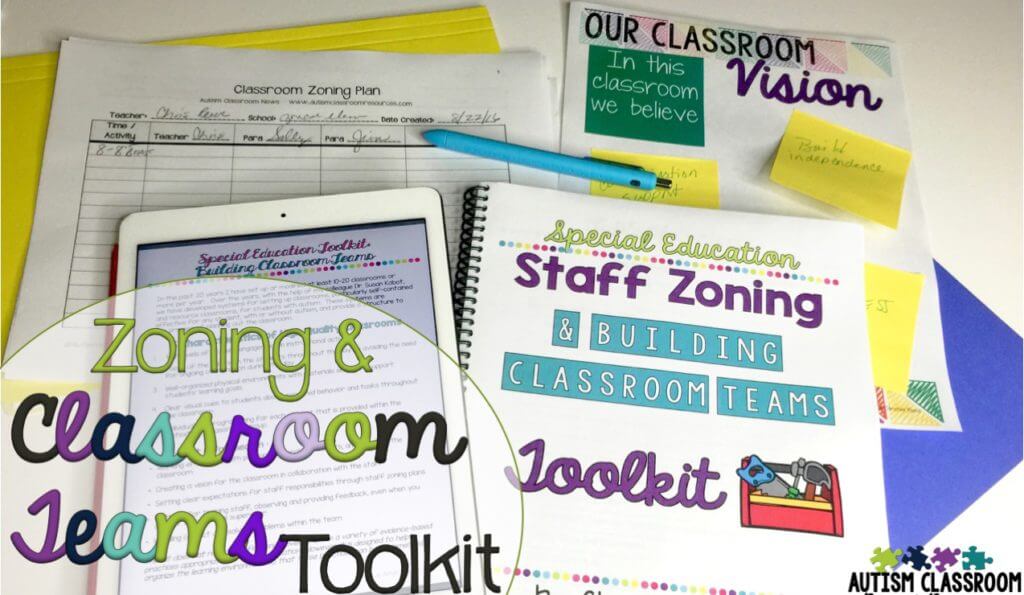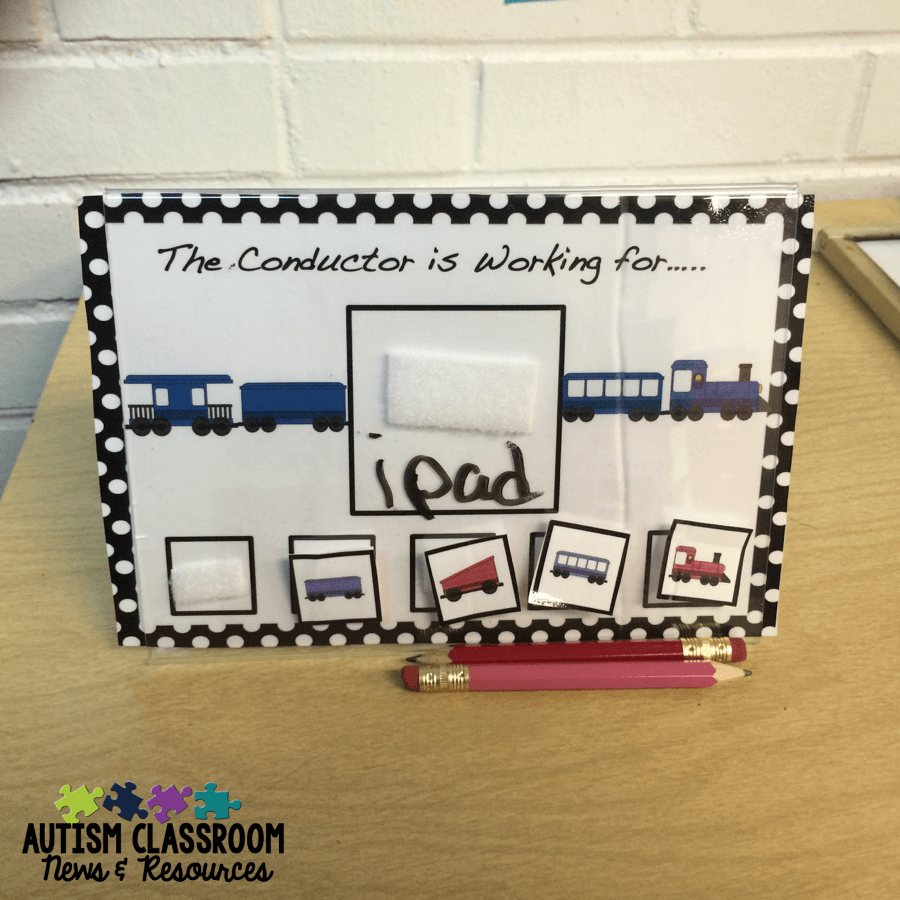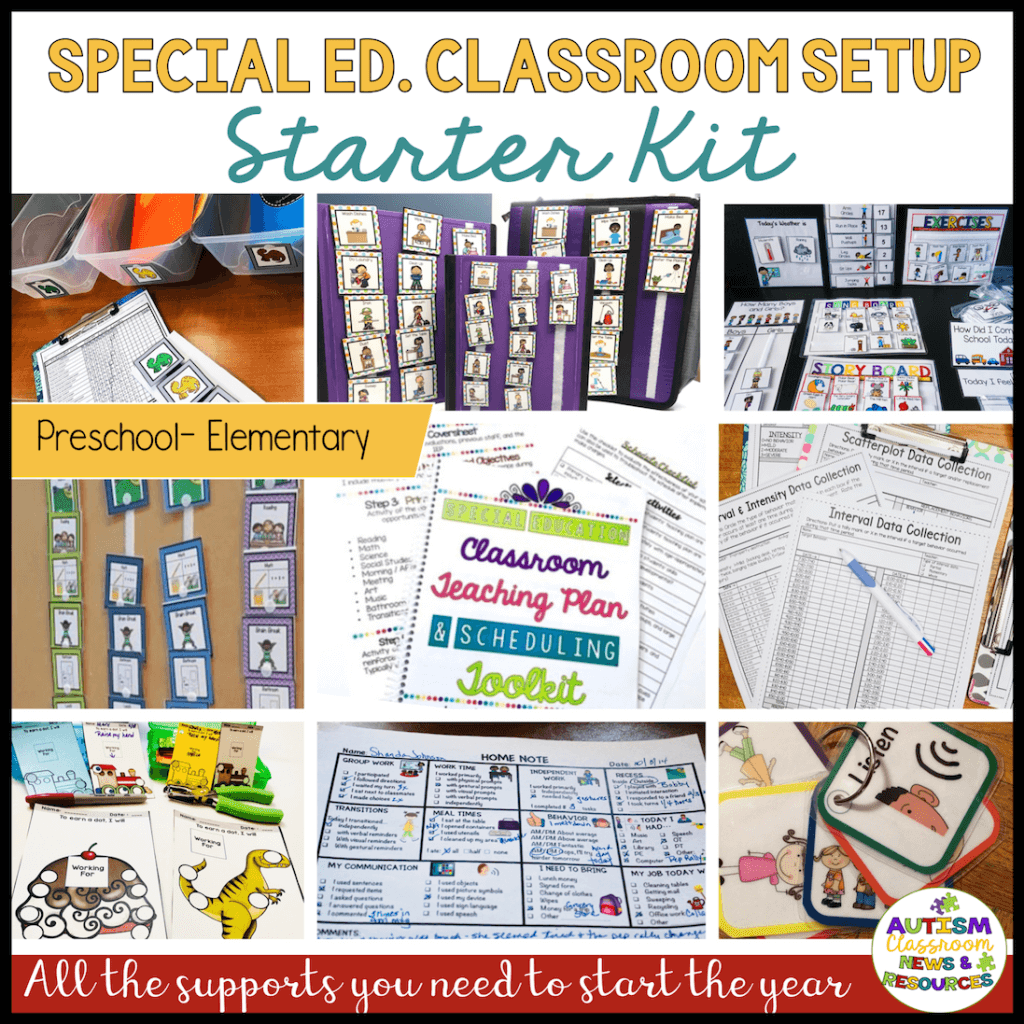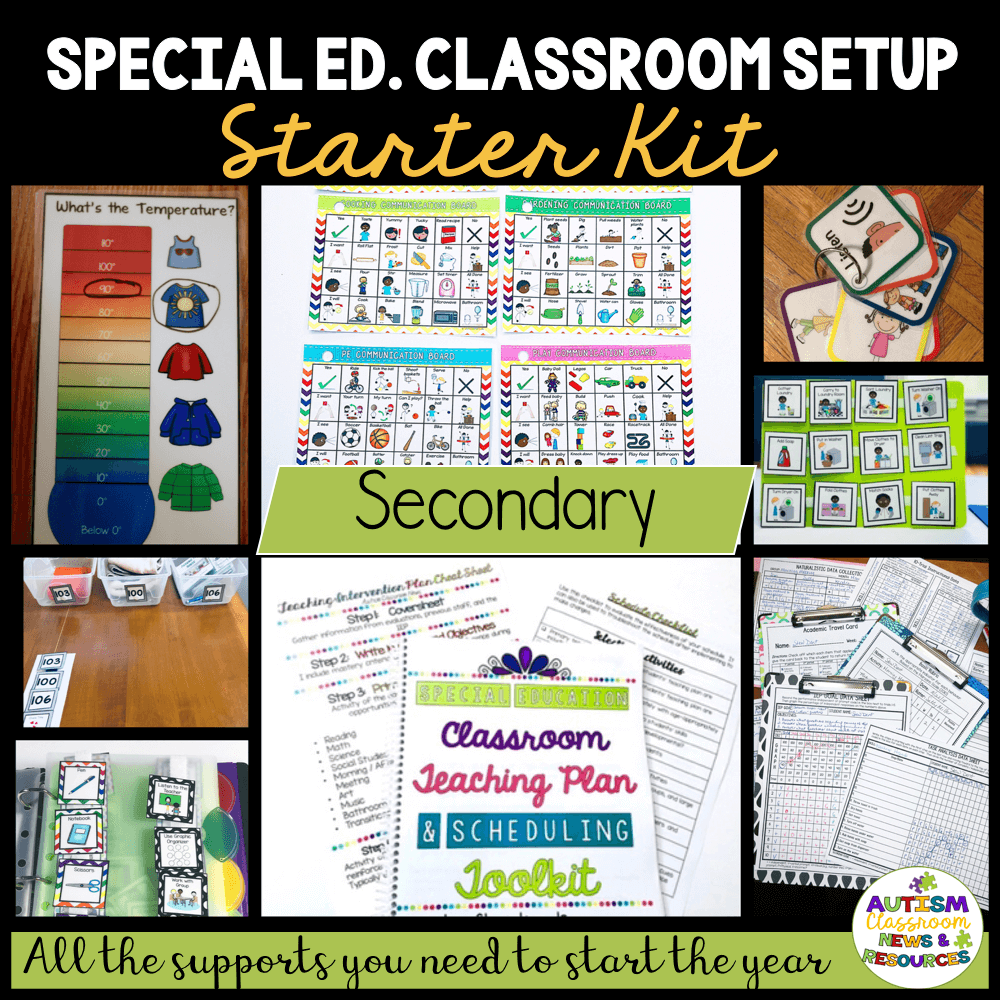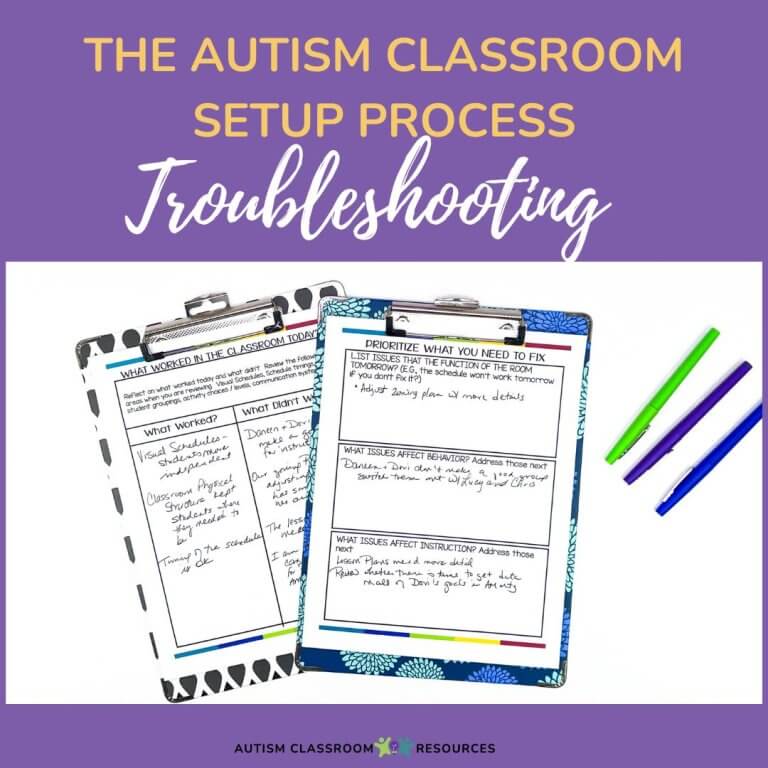Sharing is caring!
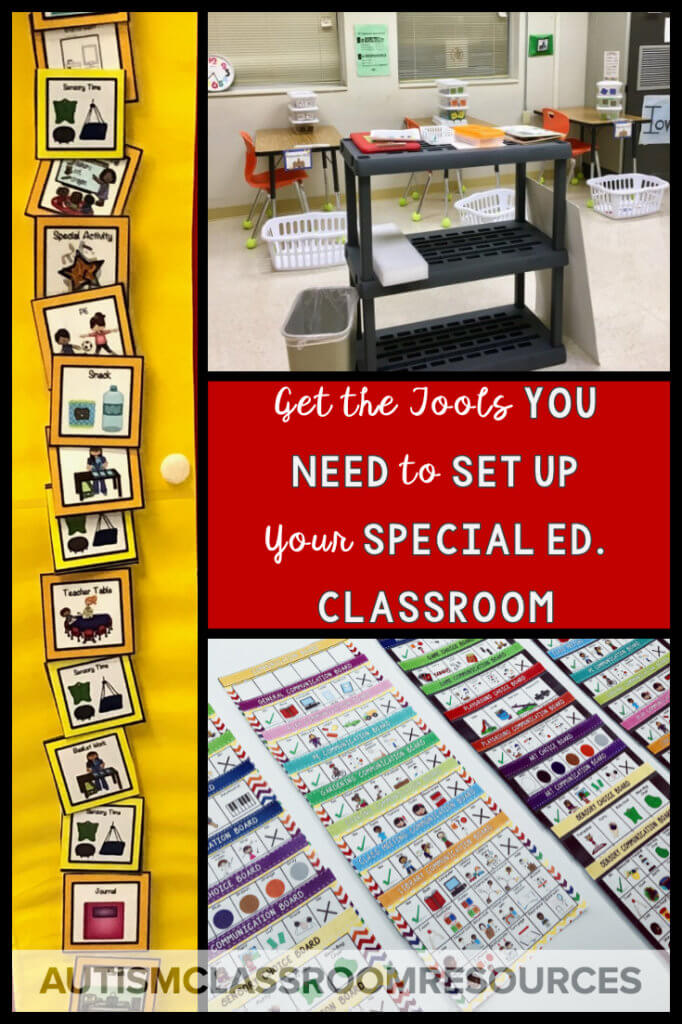
Setting up classrooms in special ed can be tough. Over the years, I have set up more classrooms than I care to count for all different types of students and programs. I know that setting up a classroom can be stressful. And it’s often done under a lot of stress and time pressure. So, whenever you find this article…setting up at the beginning of the year, or taking over a classroom in the new semester, making sure you have the tools you need, and some helpful support along the way, makes a huge difference.
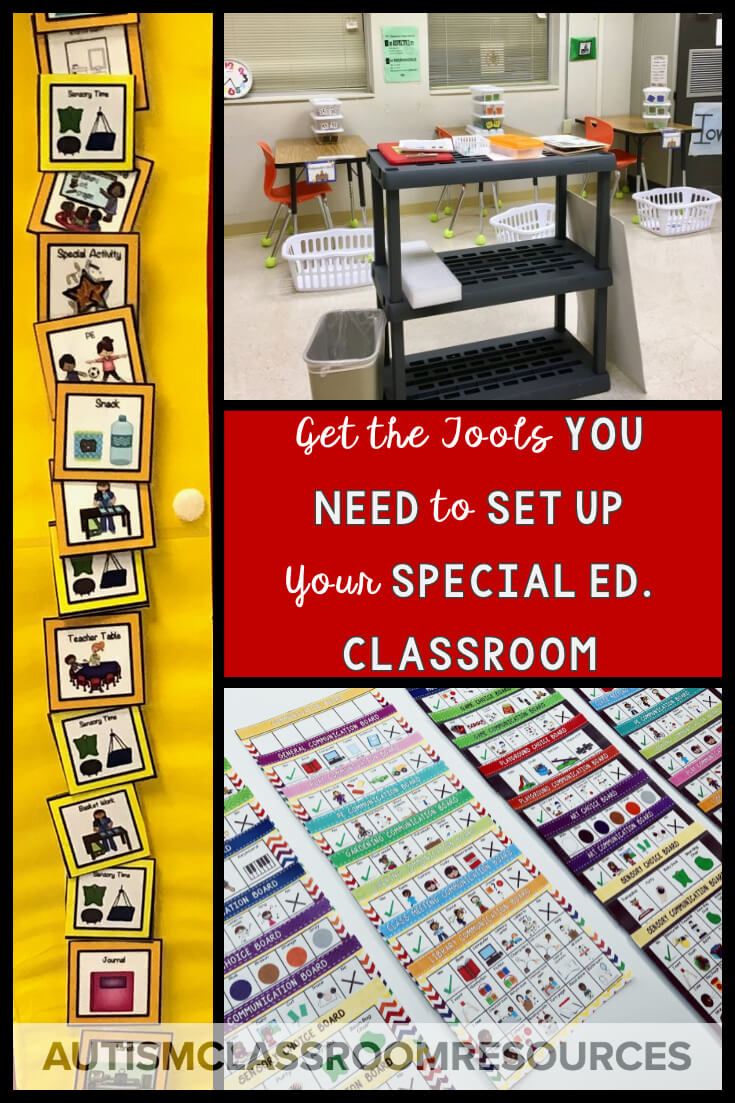
As I said, I’ve set up many classrooms over the years and in fact at times I felt like that was what I did for a living. A team of consultants would go into a teacher’s classroom and either set it up or reset it in 3 days. Then we would run the classroom for a day and coach the staff running the classroom on the 5th day. It was a system that we got really good at knowing what we needed and putting things in place.
So, as I’ve created materials for TpT over the years, I have included the elements of this system. And this past summer I was able to put it all together into 1 toolkit that has everything you need (minus bins and other materials) to get the classroom setup and running right.
There are 2 versions of the toolkits. One for preschool and elementary (Primary) and one for middle and high school (Secondary). This allows the materials to be age-appropriate, but it will cover the things you need to set up a self-contained or resource classroom for that age group. If you are looking for materials to help include students in general education throughout the day, the Starter Kit for Successful Inclusion might be a better fit.
Creating the Framework for Setting Up Classrooms
Before we even start putting up our schedules and visual supports, we have to have a framework and a plan for the classroom. This means we have to get to know our students and work out our classroom schedule. In order to do that, I use the Teaching Intervention Plan to plan out the students’ programs. It links the student’s IEP goals/objectives to the teaching strategies and times on the classroom schedule.
Once I have the TIPs done, then I can move on to creating the daily schedule based on the needs of the students. The schedule can be both the most difficult and the most crucial piece of the whole process. A well-structured schedule makes the day run much smoother.
To help with creating the TIPs and then moving forward with the schedule, both versions of the Starter Kits include the Special Education Classroom Teaching Plan and Scheduling Toolkit. This toolkit has fully-editable forms for the TIP and the schedule. But more importantly it walks you through how to use them.
You can read more about the Teaching Intervention Plan and the toolkit here.
Once you have the TIPs done, you are ready to set up the schedule. The Special Education Classroom Building Classroom Teams & Zoning Plans Toolkit is designed to help you manage the adults in the classroom. It covers everything from getting to know your staff and building relationships to how to set up the classroom staff schedule, or zoning plan. Like the toolkit before, the Team Building toolkit includes all the editable forms you need to set up the classroom vision and to zone the staff. In addition it includes
- an e-book for how to start the year off right with your staff
- a video that walks you through how to schedule your staff successfully
- multiple vision statement templates
- a cheat sheet to use when setting up your zoning plans
- a checklist for checking your zoning plans
- zoning plan examples for all ages with explanations
- and more
You can read more about what’s included in the Building Classroom Teams & Zoning Plans Toolkit in this post.
Visual Supports for Students
We all know that our students need a ton of visual supports. It feels like you can never have enough of them. So, obviously any starter kit has to start with the visuals you and your students need to be successful.
So, this kit has lots of them. It includes my Autism Pre-K – Elementary Classroom Visual Set Solid Colors or the Autism Middle-High School Classroom Visual Set. Within each of those sets there are:
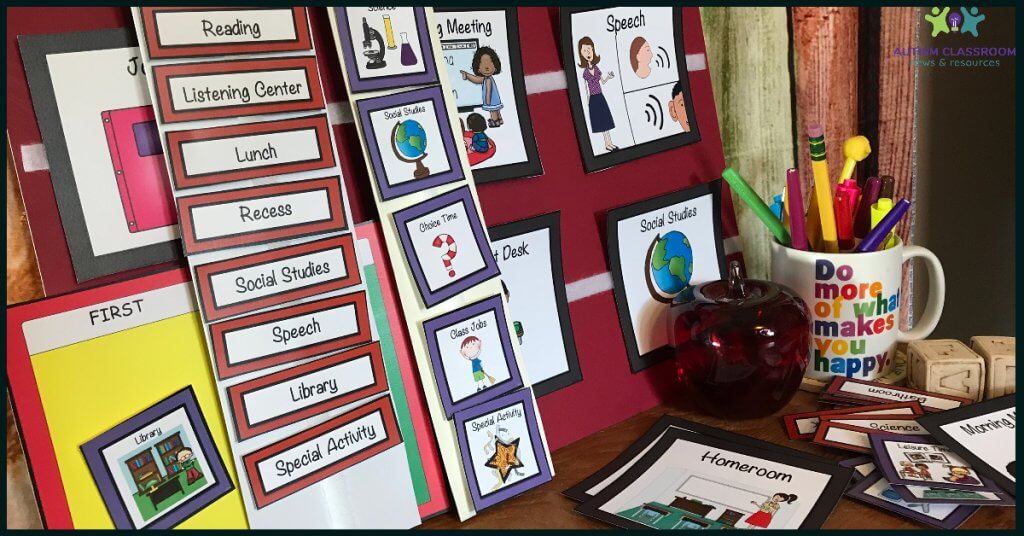
- Individual daily schedule visuals (66 icons in the set) on 15 different colored backgrounds for color coding.
- 67 Group and Check-In visuals matching the daily schedule
- 66 written icons on different colored backgrounds for students who can read
- 20 Classroom Jobs that are age-appropriate for each set
- 2 Sets of Classroom Rules
- 12-Icon lanyard visuals
- First-Then Boards
- Stop Signs
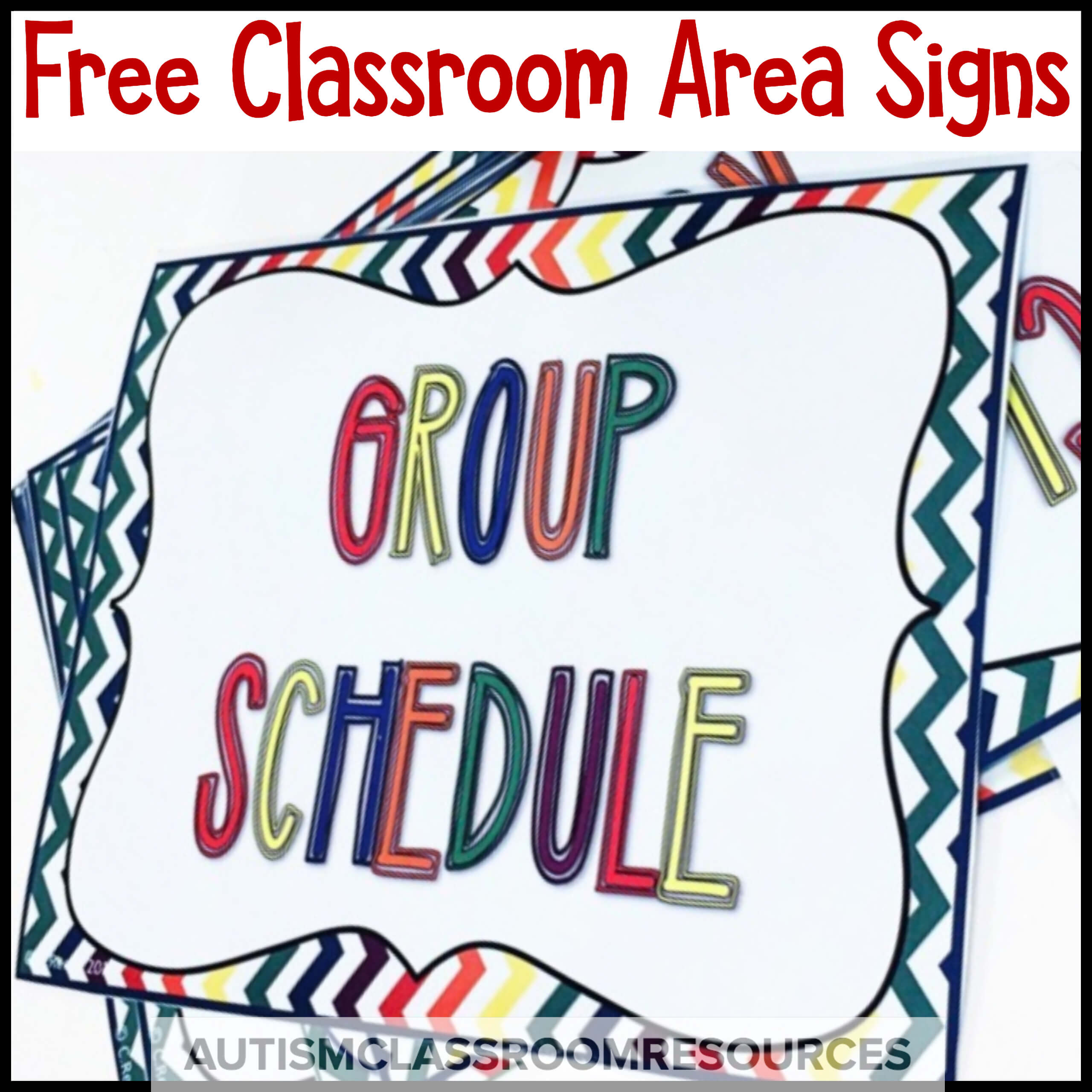
FREE in the Resource Library
Grab your free classroom signs in the resource library and get ready to get organized!
Next up from the daily schedule are the mini-schedules we use for task analyses. These are great for common routines like arrival and departure. They are also useful for life skills activities in the classroom.
In the elementary starter kit, I’ve included the general / academic set and the life skills set. I chose these because they are the ones that most elementary students use throughout their day. The general academic set includes the visuals for working in the classroom (e.g., listen to the teacher, materials to gather for an activity). They also include visuals for specials activities like art and music. The life skills sets provide the visuals for supporting activities like dressing, cooking, and classroom job activities.
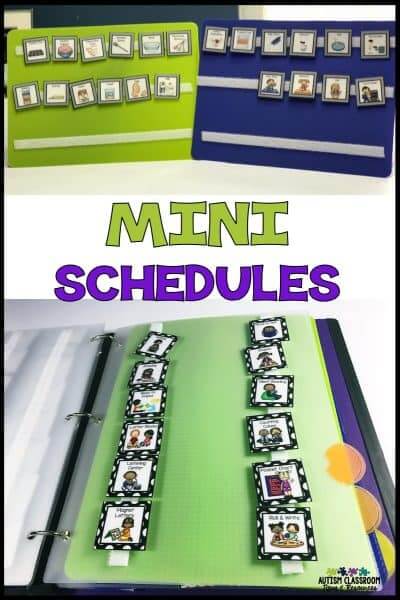
The middle and high school starter kit has those 2 sets from elementary as well as vocational visuals, community-based instruction visuals, and leisure visuals. This provides the supports needed for students working on job sites, making community outings, and learning to engage themselves in leisure activities. This means for the secondary starter kit, you have the whole bundle of mini-schedules included, in addition to the daily schedules.
Visual Supports for Staff
Next up, we need visuals for the staff. We all need reminders now and then. This set is designed to help all of us in the classroom easily reference:
- Reinforcers students receive
- Target skills for specific activities
- The prompting hierarchy to use to build independence
- Praise phrases and more
Morning Meeting Tools
Keeping students engaged in morning meeting or any larger group activity can be a challenge in a room for students with disabilities. This is especially true when you are working with students with all different types of disabilities.
So, to set up a classroom, have set routines and visual supports for morning meeting is a critical component for me. In these bundles, the Preschool-Elementary Starter Kit has the Preschool – Elementary Morning Meeting Starter Kit included. For middle and high school, there is a Middle and High School Morning Meeting Starter Kit.
Both include calendar set ups with visuals and dates, weather, and exercise routines. Each also has age-appropriate song and story boards as well as visuals for how the students came to school.
The preschool-elementary set includes visual supports for common songs, stories and movement activities for young students including Wheels on the Bus and 5 Little Ducks. Plus it includes calendar and activities in print and digital formats.
The middle-high school set includes 3 original interactive books including
- Let’s Go Shopping-Grocery shopping for cooking apple dessert
- Paying for Purchases-methods of payment for purchases
- Where Do We Find Things at School—2 versions—matching identical room pictures and matching illustrations of associated items or actions to rooms
It also includes print and digital options in the bundle.
Communication Supports
Some of your students may have their own communication device. Others may just need some additional support for speaking. And others may not yet have a device but need ways to start building their communication.
Both of the starter kits include these boards to help engineer your classroom for communication. They are not designed to replace or substitute for individual augmentative communication systems. But they are designed to add extra visuals in each area you might need them.
Independent Work Starter Kits
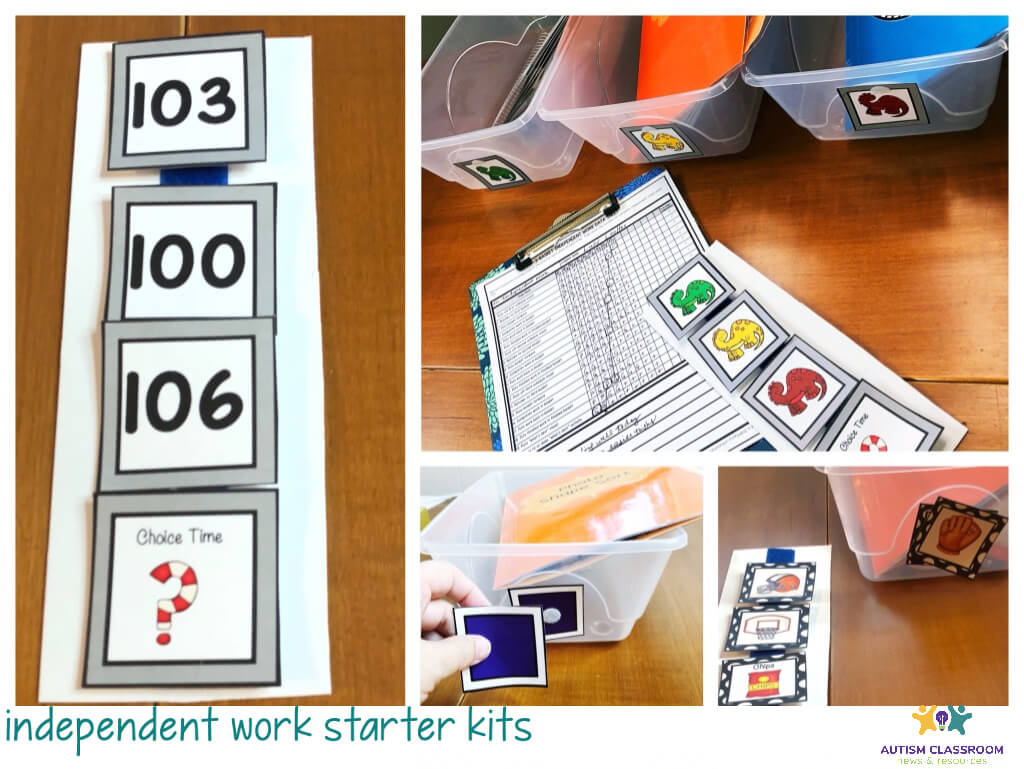
Each classroom set up kit includes an independent work starter kit designed to match the age level of your learners. Both sets include the following:
- An e-book (PDF) of directions for setting up independent work systems in your classroom and resources for tasks.
- A sign for independent work area (5 backgrounds)
- Schedule Visuals -different visuals are provided for the different age groups (e.g., dinosaur matching for preschool / elementary and common objects like safety signs for middle/high school).
- 2 finished signs (that can be reproduced for as many stations as needed) for the finished area or finished box/bin. (each in 5 backgrounds)
- 2 pages of common reinforcer or “what’s next” pictures (5 backgrounds)
- PDF and PowerPoint Editable (add info only) Mastery Lists
- Independent Work Reminders Poster
- Independent Work Data Sheets for 1, 2, 3, and 4 -basket systems
- List for other starter materials needed for work systems along with resources for making tasks
- Links to a video and backgrounds for adding your own visuals to the system with the same backgrounds.
Check out the preschool-elementary starter kit here and the secondary starter kit here.
Parent Communication Sheets
These sheets are designed for easy and efficient communication with families. For special education classrooms, in particular, parents find it difficult to get information from their children about their day. This is in part, usually, to difficulties with communication.
These sheets can be used for staff to check-off and then the teacher to review and send home. They also could be completed by students in some situations. And each set includes a note that parents can complete about the student’s time at home as well.
You can edit the notes to add information. The titles and boxes can’t be changed, but you can add all the checkboxes that you want for your students.
The preschool / elementary classroom set up kit includes the Preschool and the Elementary homenote sets. The middle / high school set up kit includes the secondary notes.
Behavior Supports
Each set up kit includes social stories and visual cues to help students follow common routines during the classroom day. I have used them successfully with a wide variety of students who don’t have autism as well. And they just got a new makeover for younger and OLDER students!!
Each story is in a format with one idea and picture on each page and an identical story in which the whole story is contained on 1 page with a picture for each idea next to the line.
3 social narratives regarding Lining Up
- Lining up in Class
- Walking in Line
- I Can’t Always be First
5 narratives address raising hands and waiting to be called on.
- Raising My Hand to Talk in Class
- Waiting to be Called on to Talk
- When Someone Else Says My Answer
- When the Teacher Calls on Someone Else
- Not Answering Upsets Me
1 narrative, When the Teacher Gives a Direction to the Class
8 Visual Cues: to remind students of coping strategies and expectations
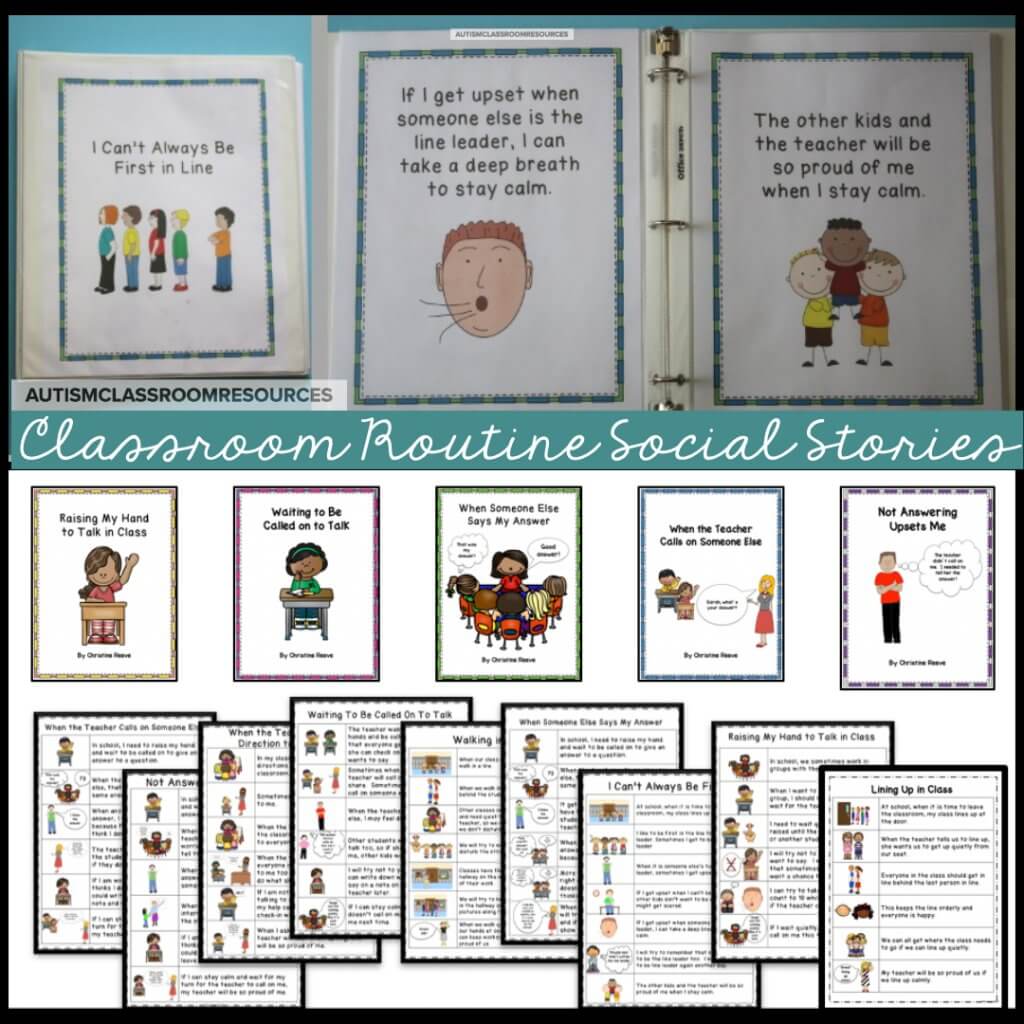
Reinforcement
The preschool- elementary setup kit includes 2 kinds of token systems to use for reinforcement. The first is Punch-Out Reinforcement Cards. These colorful cards of different reinforcing items can be used as part of a token system to build skills.
These cards provide an easy way to use a token system with students whose appropriate behavior you are trying to increase. They require minimum prep because you can print them, cut them, and punch them with a hole puncher.
Also included in the preschool – elementary kit are a set of visual token boards with themes common to this age student. The sets come with 5 or 10 token spaces and are great for using as “working for” boards for instruction or for reinforcement of appropriate behavior during activities.
Data Collection
Finally, each of the classroom setup kits includes my Behavioral Data Sheet MegaPack and my Instructional Data Sheet MegaPack. Each of them have editable versions so that you can add information like objectives, names, and program steps.
Together the two sets provide multiple versions of:
- Rating Scales
- Self-graphing Instructional Sheets
- Self-graphing Frequency Data Sheets
- Scatterplots
- Interval Data Sheets
- ABC Data Sheets
- Travel Cards
- Self-graphing Instructional Sheets
- Naturalistic and Group Data Sheets
- Task Analysis Self-graphing Data Sheets
- Rubric Templates
- Discrete Trial Cards
- Work Product Labels
I hope this has given you an overview of everything you get in each of the starter kits. You can see more details about each product in my store by clicking on the title of the product in this post. By buying the bundle, you save 10% or more than $11 on each bundle.
Have questions about any of the products or the bundles? Feel free to reach out via the email button at the top of this page.
And click either of the pictures to purchase them in my store!



